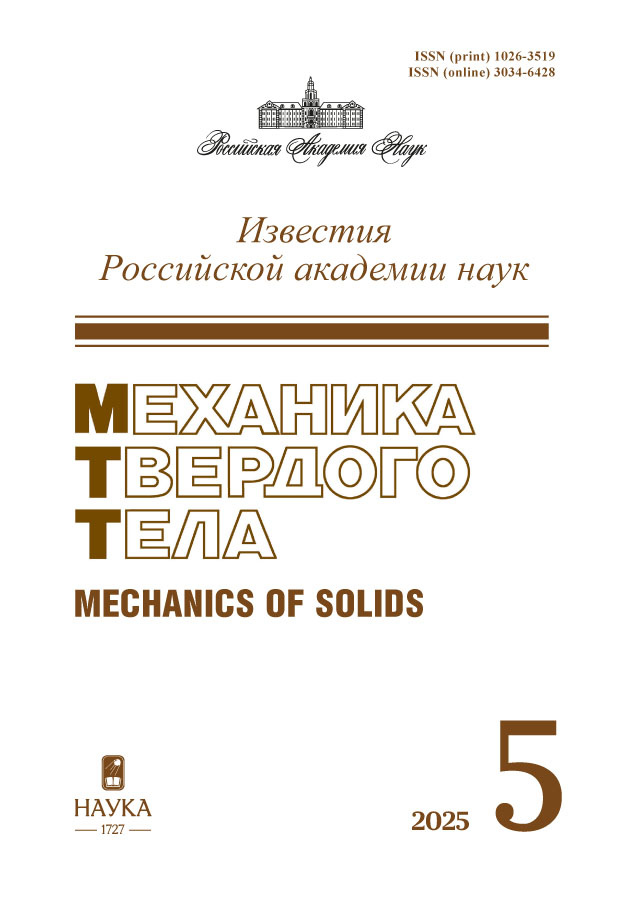On the Relationship Between Classical Mathematical and New Physical-Mathematical Theories of Metal Plasticity
- 作者: Greshnov V.M.1
-
隶属关系:
- Ufa University of Science and Technology
- 期: 编号 5 (2025)
- 页面: 144-161
- 栏目: Articles
- URL: https://jdigitaldiagnostics.com/1026-3519/article/view/691679
- DOI: https://doi.org/10.31857/S1026351925050085
- EDN: https://elibrary.ru/bvmzgs
- ID: 691679
如何引用文章
详细
Currently, there are two theories of metal plasticity in solid mechanics: the classical mathematical theory of plasticity [1, 2] and the physical and mathematical theory of plasticity [3]. Both theories are used to solve applied problems of plasticity, in particular, in the development and improvement of technological processes of metal pressure treatment [5–7]. This paper examines the relationship between the above-mentioned theories. Based on the analysis of the initial postulates and principles, the disadvantages and advantages of the theories for solving problems of theoretical design of technological processes of metal pressure treatment are identified. The analysis allows us to assert that the physical and mathematical theory of plasticity is a more general theory, which includes the mathematical theory of plasticity as a special case and which does not have the disadvantages of the latter. It follows from this that the physical and mathematical theory of metal plasticity is an important scientific achievement in solid mechanics.
作者简介
V. Greshnov
Ufa University of Science and Technology
Email: greshnov_vm@list.ru
Ufa, Republic of Bashkortostan, Russia
参考
- Ишлинский А.Ю., Ивлев Д.Д. Математическая теория пластичности. М.: Физматлит. 2001. 704 с.
- Ильюшин А.А. Пластичность. М.: Изд-во АНСССР, 1963. 271 с.
- Грешнов В.М. Физико-математическая теория больших необратимых деформаций металлов // М.: Физматлит. 2018. 232 с.
- Greshnov V.M. Physico-mathematical theory of high yrreversible strains in metals. Boca Raton; L.; N. Y.: CISP: CRC Press Taylor & Francis Group, 2019. 254 p.
- Колмогоров В.Л. Механика обработки металлов давлением. Учебник для вузов. 2-е изд., перераб. и доп. Екатеринбург: Изд-во УГЕУ УПИ, 2001. 836 с.
- Грешнов В.М., Сафин Ф.Ф., Грешнов М.В. Физико-феноменологическая модель сопротивления металлов пластической деформации для расчета технологических процессов обработки металлов давлением. Сообщ. 1 Постановка задачи и вывод общего уравнения // Проблемы прочности. 2002. № 6. С. 107–115.
- Грешнов В.М., Боткин А.В., Напалков А.В., Лавриненко Ю.А. Математическое моделирование многопереходных процессов холодной объемной штамповки на основе физико-математической теории пластического формообразования металлов. Часть 1. Расчет напряженно-деформированного состояния. // Кузнечно-штамповочное производство. Обработка материалов давлением. 2011. № 10. С. 34–39.
- Saint-Venant B. Mémoire sur l’établissement des équations différentielles des mouvements intérieurs opérés dans les corps solides ductiles au delà des limites où l’élasticité pourrait les ramener à leur premier état. // Liouville J. 1871. (2) XVI. P. 308–316, 373–382.
- Mises R. Mechanic der plastischen formanderung von kristallen // ZAMM. 1928. V. 8. № 3. P. 161–184.
- Хилл Р. Математическая теория пластичности. Пер. с англ. Э.И. Григолюка. М.: Гостехиздат, 1956. 407 с.
- Надаи А. Пластичность и разрушение твердых тел. Т.1. Пер. с англ. Под ред. Г.С. Шапиро. М.: Мир, 1969. 863 с.
- Качанов Л.М. Основы теории пластичности. М.: Наука, 1969. 420 c.
- Соколовский В.В. Теория пластичности. М.: Высшая школа, 1969. 608 с.
- Клюшников В.Д. Математическая теория пластичности. М.: МГУ, 1979. 207 c.
- Грешнов В.М., Шайхутдинов Р.И. О кинетической физико-математической теории ползучести металлов, контролируемой термоактивированным скольжением дислокаций // Изв. РАН. МТТ. 2024. № 2. С. 305–324. https://doi.org/10.31857/S1026351924020157
- Грешнов В.М., Шайхутдинов Р.И., Пучкова И.В. Кинетическая физико-феноменологическая модель длительной прочности металлов // Прикладная механика и техническая физика. 2017. Т. 58. № 1. С. 165–172. https://doi.org/10.15372/PMTF20170118
- Ishlinsky A.Yu., Ivlev D.D. Mathematical theory of plasticity. M.: Fizmatlit, 2001. 704 p.
- Ilyushin A.A. Plasticity. M.: Publishing house of the Academy of Sciences of the USSR, 1963. 271 p.
- Greshnov V.M. Physical and mathematical theory of large irreversible deformations of metals. M.: Fizmatlit, 2018. 232 p.
- Greshnov V.M. Physico-Mathematical Theory of High Yrreversible Strains in Metalls // Boca Raton; L.; N. Y.: CISP: CRC Press Taylor & Francis Group, 2019.
- Kolmogorov V.L. Mechanics of metal forming. Textbook for universities. 2nd ed., revised and enlarged. Ekaterinburg: Publishing house of the Ural State Technical University UPI, 2001. 836 p.
- Greshnov V.M. et al. Physical and phenomenological model of metal resistance to plastic deformation for calculating technological processes of metal pressure treatment. Communication 1 Statement of the problem and derivation of the general equation // Problems of Strength 2002. № 6. P. 107–115.
- Greshnov V.M. et al. Mathematical modeling of multi-transition processes of cold volume stamping based on the physical and mathematical theory of plastic forming of metals. Part 1. Calculation of the stress-strain state // Forging and stamping production. Processing of materials by pressure. 2011. № 10. P. 34–39.
- Saint-Venant B. Mémoire sur l’établissement des équations différentielles des mouvements intérieurs opérés dans les corps solides ductiles au delà des limites où l’élasticité pourrait les ramener à leur premier état // Liouville J. 1871. (2) XVI. P. 308–316, 373–382.
- Mises R. Mechanic der plastischen formanderung von kristallen // ZAMM. 1928. V. 8. № 3. P. 161–184.
- Hill R. Mathematical theory of plasticity // Translated from English by E.I. Grigolyuk. Moscow: Gostekhizdat, 1956. 407 p.
- Nadai A. Plasticity and fracture of solids. Vol. 1: Trans. from English. Ed. by G.S. Shapiro. M.: Mir, 1969. 863 p.
- Kachanov L.M. Fundamentals of the Theory of Plasticity. M.: Nauka, 1969.
- Sokolovsky V.V. Theory of plasticity. M.: Higher School, 1969. 608 p.
- Klyushnikov V.D. Mathematical theory of plasticity. M.: Moscow State University, 1979.
- Greshnov V.M., Shaikhutdinov R.I. On the kinetic physical and mathematical metal creep theory controlled by thermally activated dislocation sliding // Izvestiâ Akademii nauk. Rossijskaâ akademiâ nauk. Mehanika tverdogo tela. 2024. № 2. P. 305–324.
- https//doi.org/10.31857/S1026351924020157
- Greshnov V.M., Shaikhutdinov R.I., Puchkova I.V. Kinetic physical phenomenological model of creep-rupture strength of metals // Journal of Applied Mechanics and Technical Physics. 2017. V. 58. № 1. P. 165–172. https//doi.org/10.1134/S0021894417010187
补充文件









